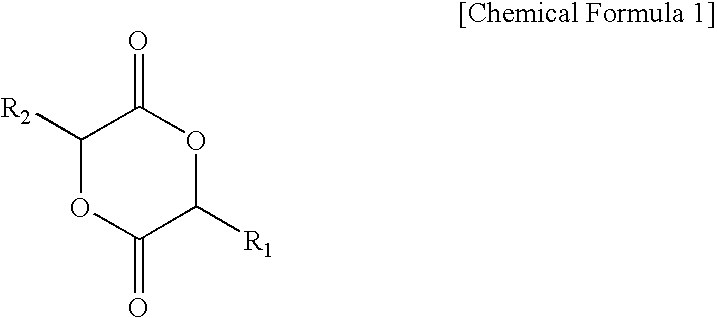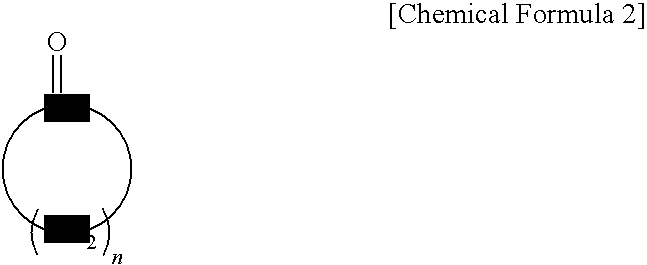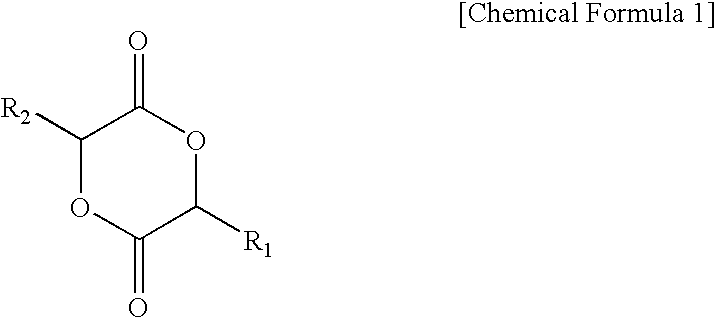Aliphatic Polyester Copolymer, Method for Preparing the Same and Polylactic Acid Resin Composition Using the Same
- Summary
- Abstract
- Description
- Claims
- Application Information
AI Technical Summary
Benefits of technology
Problems solved by technology
Method used
Image
Examples
example 1
Preparation of Aliphatic Polyester Copolymer
[0064]After injecting 4 g of a bisphenol A type epoxy resin (YD-017 having a molecular weight of 9,000 g / mol manufactured by KUKDO Chemical Co., Ltd.) and 15 g of L-lactide into a glass polymerization tube and substituting it with a purge gas (nitrogen gas), the purged mixture was heated to 190° C. while stirring the mixture. When the two materials are externally uniformly mixed at 190° C., 4.2 mg of stannous octoate as a polymerization catalyst is injected into the glass polymerization tube, and the resulting mixture is maintained at 190° C. for 5 hours. After separating a polymer from the glass tube, the polymer is dissolved into 50 ml of chloroform to produce a chloroform polymer solution. The chloroform polymer solution is stirred into 800 ml of a methanol solution and simultaneously precipitated, and thus non-reacted monomer is removed. 17 g of a copolymer EB1 is obtained in which polylactic acid is introduced into a main chain of the...
example 2
[0075]An aliphatic polyester copolymer is prepared in the same manner as in Example 1 except that 7 g of a bisphenol A type epoxy resin (YD-017 having a molecular weight of 9,000 g / mol manufactured by KUKDO Chemical Co., Ltd.), 10 g of L-lactide, and 2.8 mg of stannous octoate as a polymerization catalyst are used. 15 g of a copolymer EB2 in which polylactic acid is introduced into a main chain of the bisphenol A type resin in the form of a graft is obtained. The yield of the copolymer is 88%, and the molecular weight and molecular weight distribution thereof measured by gel permeation chromatography are 65,000 g / mol and 5.6, respectively. The glass transition temperature (Tg) of the copolymer is 50° C. as determined using differential scanning calorimetry analysis, and the melting temperature (Tm) thereof is not observed.
[0076]A polylactic acid resin composition is prepared in the same manner as in Example 1 except that the aliphatic polyester copolymer EB2 is used as represented i...
example 3
[0077]A polylactic acid resin composition is prepared in the same manner as in Example 1 except that the aliphatic polyester copolymer EB2 prepared in Example 2 is used and the amounts of the components in the resin composition are changed as represented in the following Table 1.
PUM
| Property | Measurement | Unit |
|---|---|---|
| Temperature | aaaaa | aaaaa |
| Percent by mass | aaaaa | aaaaa |
| Percent by mass | aaaaa | aaaaa |
Abstract
Description
Claims
Application Information
 Login to View More
Login to View More - R&D
- Intellectual Property
- Life Sciences
- Materials
- Tech Scout
- Unparalleled Data Quality
- Higher Quality Content
- 60% Fewer Hallucinations
Browse by: Latest US Patents, China's latest patents, Technical Efficacy Thesaurus, Application Domain, Technology Topic, Popular Technical Reports.
© 2025 PatSnap. All rights reserved.Legal|Privacy policy|Modern Slavery Act Transparency Statement|Sitemap|About US| Contact US: help@patsnap.com



